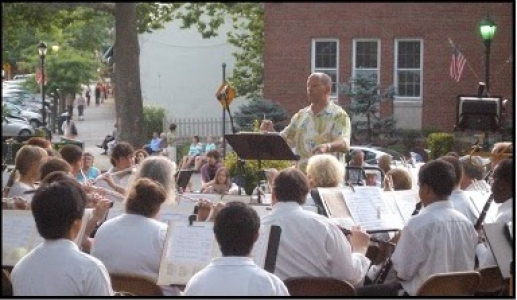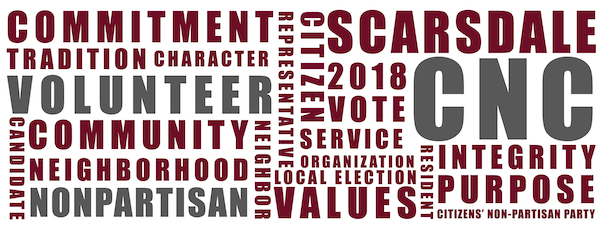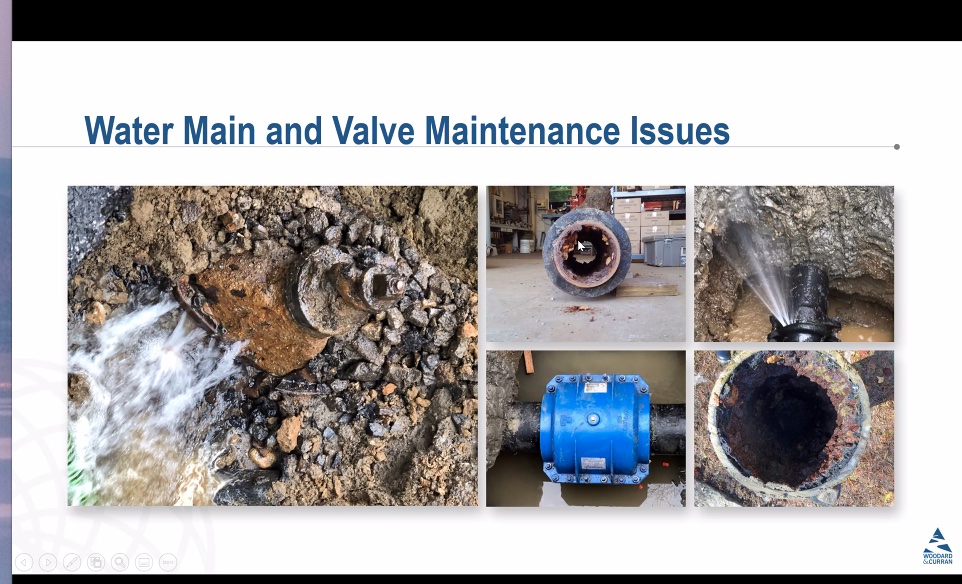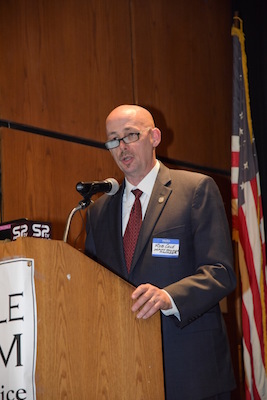Severe Rainstorm Causes Flooding in Scarsdale
- Details
- Written by: Joanne Wallenstein
- Hits: 5293
 The severe rainstorm on July 8 caused flooding, road closures and trouble for drivers and homeowners. Police, firemen and staff from the highway department set up barricades on flooded streets to prevent cars from getting stuck in deep water.
The severe rainstorm on July 8 caused flooding, road closures and trouble for drivers and homeowners. Police, firemen and staff from the highway department set up barricades on flooded streets to prevent cars from getting stuck in deep water.
We received the photo above of a car swamped in the high school parking lot and a report of kids swimming in the flooded lot just before midnight on July 8, 2021.
Also reported were:
At 3:03 pm --Flooding on Rugby Lane where a resident thought a water main had broken – but the problem was the rain.
At 3:30 pm - A tree branch fell on a power line at the intersection of Heathcote and Post Roads
At 3:40 pm – a car flooded on Brookby Road and had to be towed away.
At 3:42 pm - a car flooded at Popham Road and Depot Place and was towed away.
At 3:50 pm – a telephone pole at 2 Weaver Street was struck by lightening.
At 3:53 pm – a car was stuck in high water at the intersection of Paddington and Fox Meadow Roads and was towed.
At 4:07 pm – Greendale Road flooded and was closed.
At 4:20 pm – the intersection of Sprague and Clarence Road flooded and the road was closed.
At 4:32 pm – a car got stuck at the intersection of Sprague and Clarence Roads.
At 5:45 pm –a bus got stuck at the same location and had to be evacuated All the passengers were driven to their destinations and the bus was towed.
At 7:45 am on July 9 – a large tree fell on the Bypass.
BOT Sets Public Hearing on Zoning Code Amendments to Reduce Home Bulk
- Details
- Written by: Joanne Wallenstein
- Hits: 1880
 Though Scarsdale residents have complained for years about the size and height of new homes and additions, they received little solace when they complained to the Building Department or went before the Board of Architectural Review. Savvy builders, skilled at maximizing the size of homes, exploited the zoning code to earn bonuses in the allowable square footage.
Though Scarsdale residents have complained for years about the size and height of new homes and additions, they received little solace when they complained to the Building Department or went before the Board of Architectural Review. Savvy builders, skilled at maximizing the size of homes, exploited the zoning code to earn bonuses in the allowable square footage.
Seeking to address these concerns, a Bulk Review Committee, the Planning Board, the Zoning Board, the Board of Architectural Review, and the Planning Department studied the issues and ultimately formulated a list of recommended changes to the zoning code to reduce the size of Scarsdale homes. In January 2021, the Village Board sent these recommendations to the Planning Board for review, and now the Planning Board has endorsed them.
In their memo to the Board of Trustees, the Planning Board explains, “One way is to look at bulk as the proliferation of homes that tower over, and are inconsistent with the scale of neighboring homes. The Planning Board understands that the floor area ratio (FAR) regulations already in place were implemented to address this issue and have been largely successful at preventing the construction of more “McMansions.” The other way to look at bulk is the gradual change in the character of the neighborhood over time as more and more new homes are built that use the maximum allowable floor area. As this trend continues, homes become taller and closer together. The Planning Board believes that the proposed changes, in combination address the latter issue.”
The Planning Board recommended that these recommendations, in particular the first three, be considered as a combined package, not as separate recommendations to be implemented individually.
Here are the five recommended changes:
1-Reduce the maximum permitted roof height from 35 feet to 32 feet;
2-Reduce the FAR side yard setback bonus by 30%;
Under current Village code a builder can add 100 square feet of floor area for each foot a house is setback beyond the required side yard set back. The new law would reduce that to 70 square feet of floor space for each foot the house is set back beyond the required minimum.
3-Eliminate the requirement that any home addition must be to the rear of the home in order to utilize the side yard FAR bonus;
This was found to incentivize builders to tear down existing homes rather than renovate them.
4-Clarify the Village Code to specify that the FAR garage credit applies to the square footage of the floor level of the garage where cars are parked, excluding space on upper floors.
This bonus was intended only for the floor area of the garage, not for any square footage in a second floor built above the garage, which is now included in the calculation.
5-Require Planning Board Site Plan approval for single family residential projects involving more than 15,000 square feet of gross floor area, eliminating review through a Special Use Permit from the Board of Appeals.
These changes will be the subject of a public hearing on Tuesday July 13, 2021 at the meeting of the Village Board at Scarsdale Village Hall.
From the Village Board: Leaf Blower Ban, Band Concerts, Village Manager Search and Tax Grievances
- Details
- Written by: Sammy Silberberg
- Hits: 2197
 As an increased number of residents become fully vaccinated and Covid-19 case numbers continue to decline, things are started to feel back to normal for the Scarsdale Village. During the Board of Trustee Business Meeting on June 8, Mayor Jane Veron addressed some of the events that will be reinstated this summer, such as Westchester Band concerts, and the full return of Village staff to Village Hall.
As an increased number of residents become fully vaccinated and Covid-19 case numbers continue to decline, things are started to feel back to normal for the Scarsdale Village. During the Board of Trustee Business Meeting on June 8, Mayor Jane Veron addressed some of the events that will be reinstated this summer, such as Westchester Band concerts, and the full return of Village staff to Village Hall.
Mayor Veron spoke about many topics in her comments, and her full statement is available at the bottom of this article: Here is an excerpt from her remarks where she addressed acceptance and safety in Scarsdale:
“One of the unifying themes of this board is the strong desire to Stand Against Hate in all of its myriad and insidious forms. We stand strong to support Black Lives Matter and to stop AAPI Hate. We recognize Pride month and support the LGBTQ community. And just today, we reaffirm that we will not tolerate antisemitism. We have joined with the United States Conference of Mayors and the American Jewish Committee to lend our name to the Mayors United Against Antisemitism. We all aspire to a world that celebrates what makes each of us unique, and we expect Scarsdale to lead with a welcoming and inclusive spirit.”
Mayor Veron also spoke about the search for a new Village Manager. She stated:
“By our May 24 deadline, we received fifty-six applications for the Village Manager position. Over the past couple weeks, GovHR conducted further vetting and follow up and narrowed the field to the top 14 candidates. GovHR is now performing extensive background checks, media searches, reference calls and zoom interviews. The Board and GovHR developed carefully crafted questions specific to Scarsdale needs, reflecting the input we received on your survey responses. After the completion of this evaluation round, the Board will receive a full report from GovHR. The next step will be a comprehensive review and discussion to identify the top candidates who will be invited to advance to the next round. The Board anticipates conducting in person interviews the week of July 19. We will also provide an opportunity for staff and the public to meet the top candidates to offer their input.”
Leaf Blower Ban
During Village Manager Pappalardo's comments, he addressed a topic at the forefront of many residents' minds – gas-powered leaf blower enforcement. Although the Board banned the use of these noisy and disruptive blowers at this time of year, enforcement and education of the new law is a challenge. Handouts were provided to residents that summarized the new law, and summonses were issued as of June 1, 2021. While the village focused on education and awareness of the policy in May, they will now be issuing penalties. Thus far, 4 violations have been issued.
Resident Susan Douglas highlighted this issue during Public Comment and stated that when she talks to people who are violating the ban, they usually say they didn't know about the change. She asked what the Board is doing in terms of outreach and communication. Deputy Manager Rob Cole emphasized that May was an education period and that the village handed out notices, sent direct mailings to every landscaper in the database, and notified the landscaping association. In addition, warnings were issued to 71 homes violating the law in May, and communications were posted on the village website and spoken about extensively at Board meetings. Manager Pappalardo also stated that the village hired two additional part-time Code Enforcement Officers. With the current staff, the village will now have coverage seven days a week to respond to complaints and enforce the law.
Tax Grievances
Manager Pappalardo also announced that Grievance Day Hearings will be held on June 15, 2021, between 10am-12pm and 7-9pm. The village will hear taxpayer grievances and review the formal complaints over the summer. Any reductions determined after deliberations will be filed by the village by September 15, 2021. Thus far, 40 grievance applications have been filed, and the filing deadline is June 15. During public comment, longtime Scarsdale resident Bob Harrison said that he is available cost-free to help people file their grievance charges. If you have any questions about the process or need assistance, you can reach Mr. Harrison at 914-646-4054 (cell) or 914-725-0962 (home).
Kyle John Barry
During the meeting, the Board adopted four measures. These included Supplemental Appropriations for Capital Budgets for Road Milling and Paving, the Levy of Village Taxes for 2021-2022, and the authorization to hold the Scarsdale Business Alliance Annual Sidewalk Sale. The final measure was the acceptance of a gift to honor Scarsdale resident Kyle John Barry. Kyle grew up down the street from Davis Park and recently passed away just days after his 28th birthday. He attended Edgewood Elementary and Scarsdale High School, and his friends and family gifted the village $1,400 to purchase a new bench and hornbeam tree in his honor in Davis Park.
Mayor’s Comments
Good evening everyone and welcome back Village staff. You’ve finally all returned to Village Hall, no longer working in cohorts but united together. It is so nice to see Village Hall back to normal, in new normalcy kind of way.
The Board is now two months into our term, and as we’ve been describing in our communications, we have established a clear process to study and manage priorities for the Village. Our new framework provides a roadmap with accountability and transparency. With weekly Tuesday work sessions, we continue to press forward on all fronts, making sure each pillar and enabler of government receives attention. I will highlight a few tonight:
Quality of Life Pillar
Over these past couple weeks, the Quality of Life Pillar has been prominent in our minds. Quality of Life is a somewhat ephemeral concept. While sometimes hard to measure with clear metrics, we certainly know when it is strong. There are most definitely environmental factors that connote good quality of life - a strong infrastructure, reliable public safety, economic vitality and the beauty and peace of tree-lined streets - but those are not sufficient. To achieve the highest quality of life, everyone must feel a sense of belonging. Each resident, worker, friend, and visitor must be put at ease and feel welcome when in our Village.
One of the unifying themes of this board is the strong desire to Stand Against Hate in all of its myriad and insidious forms. We stand strong to support Black Lives Matter and to stop AAPI Hate. We recognize Pride month and support the LGBTQ community. And just today, we reaffirm that we will not tolerate antisemitism. We have joined with the United States Conference of Mayors and the American Jewish Committee to lend our name to the Mayors United Against Antisemitism. We all aspire to a world that celebrates what makes each of us unique, and we expect Scarsdale to lead with a welcoming and inclusive spirit.
The arts also play an important role in lifting up and binding together the community. To the many residents and fans who have flooded our inboxes asking for the reinstitution of Westchester Bands concerts, we are thrilled to report that Brian Gray, our Superintendent of Parks, Recreation and Conservation, and Steve Pappalardo, our Village Manager, moved heaven and earth to pave the way for the Band’s safe return. We will be back to the Thursday night rhythm and a new sense of normalcy. More details to follow.
Infrastructure, Municipal Services and Sustainability Pillar
Our Superintendent of Public Works Jeff Coleman and his team are diligent when it comes to tracking and repairing our infrastructure. Roads are always at the top of our residents’ wish list, and we have kept them a high priority even during the pandemic. Tonight you will see that we will be able to increase our NYSDOT funded road milling and paving budget for 2020/21 and 2021/22 by $375K. We are eager recipients of supplemental NY State funding.
In the water department, we also keep up-to-date on our repair needs so that residents enjoy a clean and reliable water supply. The recent report shared at our May 24 work session outlined a multi decade plan to make needed improvements. With this road map, we will have the foresight to make proactive plans and measured improvements, synchronize with road repaving, and ensure that future generations have no reason to worry. We also position ourselves at the ready should we receive Federal infrastructure grants that seem to be percolating in Washington.
Public Safety Pillar
We are exceedingly lucky to have extraordinary public safety officials who work tirelessly to keep us safe and secure. Our police, fire, SVAC, and public safety volunteers are among the very best. One of the cornerstones of public safety success is the partnership forged with stakeholders. Later this week, the Village and the School will come together in a 2x2 to talk about our collaboration. We will review our collective approach to traffic volume at the schools, communications amongst Village and School colleagues, and our coordinated emergency response.
Special Assignments
In addition to our work on Village Pillar fundamentals, we continue to press forward on our special assignments. First and foremost is the Village Manager Search which continues in earnest. By our May 24 deadline, we received fifty-six applications for the Village Manager position. Over the past couple weeks, GovHR conducted further vetting and follow up and narrowed the field to the top 14 candidates. GovHR is now performing extensive background checks, media searches, reference calls and zoom interviews. The Board and GovHR developed carefully crafted questions specific to Scarsdale needs, reflecting the input we received on your survey responses. After the completion of this evaluation round, the Board will receive a full report from GovHR. The next step will be a comprehensive review and discussion to identify the top candidates who will be invited to advance to the next round. The Board anticipates conducting in person interviews the week of July 19. We will also provide an opportunity for staff and the public to meet the top candidates to offer their input.
A second special assignment, the Pool Complex Market Study and Assessment, is being queued up for discussion at an upcoming work session. The working group along with Deputy Village Manager Cole have discussed the objectives of an RFP and the Committee of the Whole will review the document and its goals this month. Our hope is to add this item to a work session in short order, and we invite the public to zoom in. Stay tuned for final details.
Procedure Committee Asks For Your Comments on Amendments to the Non-Partisan Resolution
- Details
- Written by: Joanne Wallenstein
- Hits: 1654
 The Scarsdale Procedure Committee (PC), whose members are representative of every elementary school neighborhood, announced today that the PC is inviting Scarsdale voters to help improve the non-partisan election system’s governing document and non-partisan system’s procedures. To accomplish this important task, the public is being invited to review and comment on proposed amendments which are available on the PC’s website as of June 1, 2021.
The Scarsdale Procedure Committee (PC), whose members are representative of every elementary school neighborhood, announced today that the PC is inviting Scarsdale voters to help improve the non-partisan election system’s governing document and non-partisan system’s procedures. To accomplish this important task, the public is being invited to review and comment on proposed amendments which are available on the PC’s website as of June 1, 2021.
According to PC Chair Becky Bach and Vice Chair Richard Pinto, “The Scarsdale community’s non-partisan system of electing qualified candidates for village office is governed by the Non-Partisan Resolution – a living document that has been amended 42 times since its adoption, most recently in November 2018. The system is administered by the PC and establishes a method for selecting a slate of qualified candidates for Mayor (every two years), Trustees (every year, due to staggered terms), and Village Justice (every four years). Periodically, the community is asked to comment on proposed changes to the Resolution which are ultimately submitted to the electorate for a vote. Today’s announcement represents one of those pivotal opportunities for Scarsdalians to weigh in and share their views as part of the review process.”
The non-partisan election system is managed by residents of Scarsdale, and it works like this: the PC administers the annual recruitment and election of voting members of the 30-member Citizen's Nominating Committee (CNC). CNC members – six residents from each of Scarsdale’s five elementary school districts – are elected by their neighbors to vet and select candidates for Village office. The CNC nominates a slate of non-partisan candidates for the positions of Mayor, Trustee and Village Justice that may be open in any given year. By contributing input on potential revisions to the Non-Partisan Resolution, Scarsdale voters play an integral role in the process that selects Village government, another unique feature of Scarsdale’s non-partisan system in which partisan politics and electioneering are avoided.
PC chairs Bach and Pinto stated: “All comments received from Scarsdale voters and community organizations during the 90-day public comment period, from June 1 through August 31, 2021, and any prior public recommendations made, will be reviewed by the Procedure Committee. At the end of this public review, the Procedure Committee will propose amendments that, in the Committee’s judgment, should be presented to the electorate for a vote the second week of November, at the same time that a new class of Citizen’s Nominating Committee members are elected by the voters to participate in the non-partisan system.”
We invite the public to review and submit comments about the proposed amendments via email to meppenstein@eppenstein.com. The proposed amendment and markup of the Non-Partisan Resolution are available on the Procedure Committee/CNC website, at http://www.scarsdaleprocedurecommittee.org/.
Contact: Becky Bach, Chair and Richard Pinto, Vice Chair
By Email: beckyhbach@gmail.com; rpinto@gmail.com
The members of the 2021 Procedure Committee are: Becky Bach; David Bunzel; Heedan Chung; Larry Dobosh; Madelaine Eppenstein; Lee Fischman; Sergi Flaster; Sarit Fuchs; Sal Jain; Linda Killian; Jon Leslie; Alan Lewis; Michelle Lichtenstein; Abby Olsen; Richard Pinto; Matt Martin; Barry Meiselman; Adam Rilander; Andrew Sereysky; Greg Soldatenko
Consultants Provide Analysis of Village's 100 Year-Old Water Distribution System: Rob Cole to Serve as Interim Village Manager
- Details
- Written by: Sammy Silberberg
- Hits: 2122
 How does Scarsdale address and manage its aging infrastructure? How does the town decide which improvements to make and how to keep up with the demands of residents?
How does Scarsdale address and manage its aging infrastructure? How does the town decide which improvements to make and how to keep up with the demands of residents?
These are among the questions the Board of Trustees sought to answer when it commissioned the firm Woodard & Curran to create a Water Demand Study and examine the needs of the village’s water infrastructure system.
After reviewing 12 applications and interviewing five firms, the Board decided in September 2020 that Woodard & Curran was the most suitable choice to conduct this analysis. During the Board’s Work Session on Tuesday, May 26, 2021, three representatives from Woodard & Curran presented their draft report to the community.
The Scarsdale water system consists of 98 miles of pipe, two pumping stations, and two water tanks. The focus of the report was the water distribution system. The firm compiled and digitized existing maps, created an updated system map, reviewed the system’s maintenance history, developed a new hydraulic model, and created a capital plan for the water distribution system.
To update the current mapping system, the firm reviewed over 500 paper maps, sketches, and notes and updated historic mapping information. They used this new mapping as the foundation for the hydraulic model. Using the model, they simulated and analyzed the flow of water through the system, evaluated fire flow availability, and gauged how the system responds to issues. The model accounts for friction from areas of older pipes and factors in where water is used most frequently.
The standard recommended system pressure is 35 pounds per square inch (PSI), and Scarsdale’s system achieves this figure except for a few spots in higher elevation areas. Pipe velocity was up to code throughout the system, and water pressure loss was worst in areas with unlined cast-iron pipes. In terms of fire protection, most of the system has greater than 1000 gallons per minute of protection, with a few higher elevation areas having less than 500.
When reviewing the system’s maintenance history, the firm found several issue areas that consisted of older and unlined pipes. There were around 200 water main breaks and pipe failures between 2008-2020, which the representatives identified as a high number of issues, but said the figure was not unexpected.
In developing an improvement plan, Woodard & Curran prioritized the areas of highest maintenance needs and ranked remaining pipe segments on the likelihood and consequences of failure. In total, 76 pipe rehabilitation projects were identified for an estimated total of $103 million. The firm identified the top three priority projects:
1. Crossway: A section of unlined universal joint segment that is corroded. The proposed solution is the replacement of three-quarters of a mile of pipe along Crossway.
2. Garden Road / Mamaroneck Road: This is one of the areas of lowest pressure and lower fire flow availability. The proposed solution is a combination of lining and replacement for two miles of piping.
3. Griffin Avenue: Another area of concern that the firm suggests focusing on.
Woodard & Curran and now in the phase of conducting a Rate Study to review the current rate structure and revenue. This study will include a cost-of-service assessment, a revenue and benchmarking assessment, and a rate model development and review. The firm’s presentation also included information and resources for various government grants and funding sources that could be potential sources of revenue for the project.
After the presentation, Board members and staff had a chance to ask the representatives questions about the report and make suggestions for future work. Trustee Crandall inquired about putting some of the electric and cable lines underground while this construction work is happening to make the village more storm resilient. In a similar vein, Deputy Village Manager Rob Cole asked if it would be possible to tie in a high-capacity data line into Post Road and bring it to the Village Center to support business development. The representatives noted that different types of projects can be joined together while the pipes are already being worked on, and these are all considerations the Board will want to consider while making project decisions. Robert Cole will serve as Interim Village Manager
Robert Cole will serve as Interim Village Manager
Ms. Crandall also asked about the issues the town of Greenburgh had when they replaced their pipes, and if the firm has done any studies on the toxicity of these pipes. The firm responded that Greenburgh’s issue was not related to toxicity but instead had to do with conventional cement lining, which will not be an issue for Scarsdale if they choose a more modern construction material.
Trustee Ahuja asked when the firm was choosing the projects for the water system, how much of the decision was based on subjective judgment versus scientific fact. The representative replied that there is a need for both when designing a plan. Engineers must evaluate where the areas of concern are based on their experience and look where the data on past pipe maintenance supports project work. He added that to develop a sensible project, subjective judgment must be applied to frame the construction in the most cost-efficient manner and to cluster groups of pipes together based on similarities and economic feasibility.
Mayor Veron, as well as other trustees, also spoke about the sustainability practices that could potentially be incorporated into the project. Village Manager Papalardo added that once funding is secured, it will be unlikely the village can accomplish more than one project every two years. He added that coordinating between the water department and the sewage department could make the whole project more effective. The Board eagerly awaits the results from Woodard & Curran’s Rate Study and looks forward to the next phase of this massive infrastructure project.
Village Manager
At the Village Board meeting following the work session, Mayor Jane Veron announced that Village Manager Steve Pappalardo will leave on July 9, 2021 and that 54 applications were received for the position. The Board plans to interview some of these candidates throughout the summer. In the interim, Deputy Village Manager Rob Cole will become Interim Village Manager of Scarsdale. He has served here for six year and worked in Oak Park, Illinois for 19 years.










